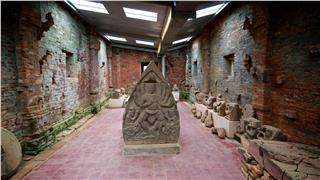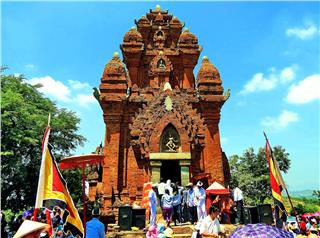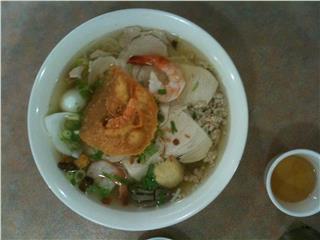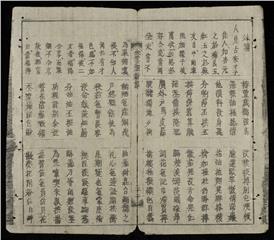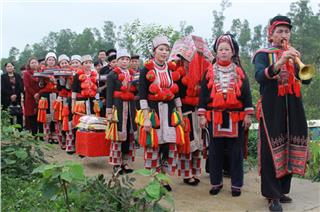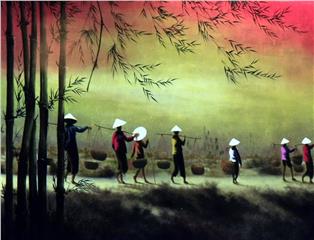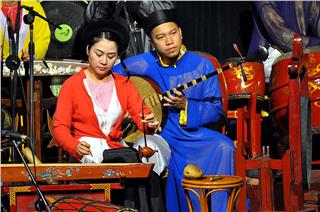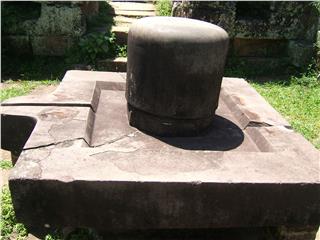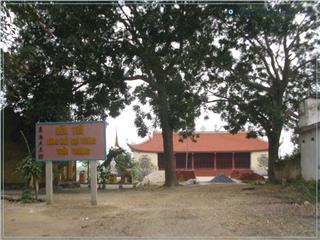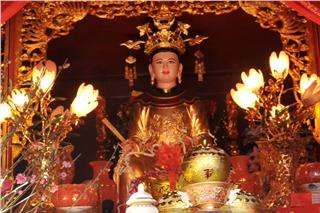Cham Muslims in An Giang
Mon, 16 Mar 2015 . Last updated Thu, 25 Jun 2015 09:02
-
 Vietnam – The S-shaped country 10088 viewed
Vietnam – The S-shaped country 10088 viewed -
 Ancient Vietnamese coins – Episode 1 9418 viewed
Ancient Vietnamese coins – Episode 1 9418 viewed -
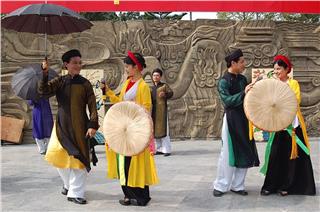 Special cultural features of Quan Ho singing 8573 viewed
Special cultural features of Quan Ho singing 8573 viewed -
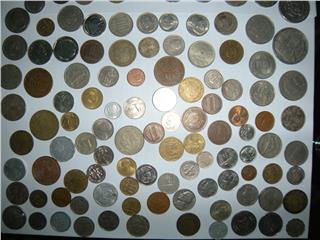 Ancient Vietnamese coins – Episode 2 8395 viewed
Ancient Vietnamese coins – Episode 2 8395 viewed -
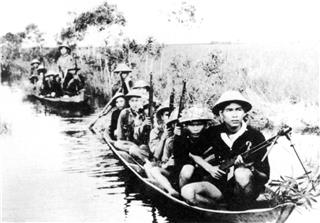 Vietnam History 1858-1945 7163 viewed
Vietnam History 1858-1945 7163 viewed -
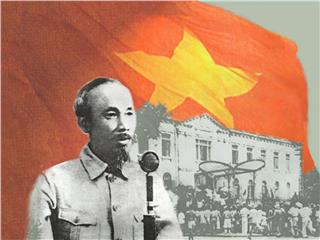 The Vietnamese Proclamation of Independence 6687 viewed
The Vietnamese Proclamation of Independence 6687 viewed -
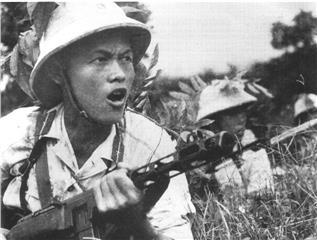 Vietnam history 1945-1954 5997 viewed
Vietnam history 1945-1954 5997 viewed -
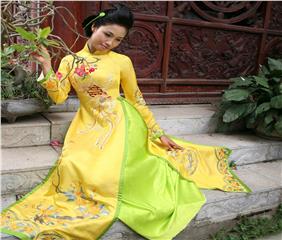 Predestined love tie with Ao Dai - Vietnamese long dress 5704 viewed
Predestined love tie with Ao Dai - Vietnamese long dress 5704 viewed -
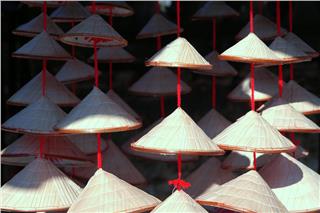 Vietnamese conical hats 5687 viewed
Vietnamese conical hats 5687 viewed
An Giang is a famous destinations appealing numerous visitors in Mekong River Delta. Coming here, visitors will have the chance to learn more about the religious life of Cham Muslims – the only ethnic group in Vietnam following the Islam.
There are about 150.000 Cham people living in different villages in provinces from Binh Dinh to An Giang, especially in Ninh Thuan, Binh Thuan and Ang Giang. Cham group is the only ethnic group in Vietnam which follows the Islam. Cham people who follow Islam in the Central Vietnam call themselves “Cham Bani” people, Cham people in the South are Cham Muslims who follow orthodox Islam, because this community still keeps many rituals and regulations of orthodox Islam compared with their brethren in the Central region. This Cham Island community has created the identity of Cham culture in the Mekong Delta.
An Giang, the fertile land created by the alluvium of Hau River is the habitat of many Vietnamese ethnic groups. The province is now home to over 10,000 Cham people who live mainly in Chau Phu, Tan Chau, An Phu and Chau Thanh. Cham people are industrious. In An Giang, they live mainly on wet rice cultivation, small business and handicrafts.
Cham People here often live in families, religious groups in villages. Each village has 300-400 households managed by a management body called “Ritual Concil” whose members include the head of the village. Cham people in An Giang follow Islam. They are serious and strictly follow five dogmas. Specifically, they pin absolute hope on Allah, attend five services a day, fast in the month of Ramadan, help poor people, and pilgrimage to the Holy Land of Mecca.
Cham people’s faith in good things plays a significant role in their spiritual life and influences their awareness, affection and will. Cham people live in a quite large community by the Hau river. They always live in harmony with other groups and preserve their cultural identity. Cham people in An Giang have many festivals; each of which comprises many special has the unique traditional rituals. The month of Ramadan is a special event to the Cham community.
Because their life is closely associated with water, they often build houses which are higher than water surface in the flood season. Therefore, the pillars of the houses are often 2-3m high. Their patterns and decorations often bear specific features of the Cham group. Cham people do not decorate their houses with pictures, statues and altars. They just hang a clock on the wall to know the time for praying and an Islamic calendar. Cham Muslims think that pictures hung in their houses will make them neglect their praying. In the dry season, the space under the floor is used for a loom and living activities.
When visiting a Cham village, we feel like we were in another world – the world of Arabian fairy tales. There is a majestic mosque in every Cham village. Cham people in An Giang do not build towers like those in the Central region, but they have a mosque in every village. The scale of the mosques varies in different villages but their architecture shares some similarities.
Each mosque has a high tower with a dome beside it. The tower has a star and a crescent moon – symbols of Islam – on it. There is a large praying ground, a favorite rendezvous for Muslims, in the village. With such architecture, a mosque reveals two directions of Islam: towards Allah and towards Muslim community, symbolized by the Holy Land of Mecca – a scared center of Muslims in the world. Perhaps for that reason, all the mosques of Cham people in An Giang turn towards the place where the Holy Land of Mecca is located.
When we come here, everyone in the village is preparing for the month of Ramanda, which takes place during September 1-30 according to Islamic calendar. The month is a chance for every Cham Muslim to review their actions over the past time, correct their mistakes and do good things. During the month of Ramadan, every Cham Muslim has to fast from dawn to dusk. They are not allowed to slaughter or quarrel with others.
In this sacred month, Cham Muslims try to do good things for the community and avoid doing evils. They also show their respect for Allah and practice all the rituals and recite the Qur’an. During the period, Cham people in An Giang often pray for peace and take part in many charitable activities.
The month of Ramadan is also the time for members of the Cham Islam community in An Giang to meet. Many people of the community have to live far from home to earn their living, but however busy they are, they come home to meet their family members, relatives and neighbors. Therefore, Cham Muslims often call the month of Ramadan the month of kindness and charity. Everyone on the Cham Islam community in An Giang is encouraged to respond to the month of Ramadan because they believe that they can prove their faith in Allah by enduring misery. There are exceptions though. Sick people, old people, children and pregnant women cannot take part in the event. Talking part in the month of Ramadan is not compulsory, but most Cham Muslims in An Giang strictly practice this ritual.
For a long time, local Cham people still preserve the special features of their costumes. Cham girls are graceful in traditional sarong which is sometimes stylized into beautiful dresses. Girls always wear a kerchief on their heads. The kerchief is released loose or covers their hair and has elegant and noble patterns. Cham men often wear checked sarong, a shirt and a round fabric hat on their heads.
Cham Muslims in An Giang always want to celebrate the month of Ramada with the most beautiful clothes. They think that clothes reveal their respect for the Supreme Being. About one month before the month of Ramadan, local people have to work till late at night to make luxurious sarong for customers to attend the event.
Wishing to get a better insight into the distinctive culture of Cham Muslims here, we come to Naep Ahmad’s house. The female members of the family are busy preparing food for the altar, the evening meal when Muslims break their fast during the Islamic month of Ramadan. Especially, Cham Muslims never eat pork.
According to the rules, every Cham Muslim has to fast in daytime during the month of Ramadan. In the daytime, they try their best not to violate any rule, which may lead o a loss of good fortune. After sunset, they eat to make up for the energy they lose during the day. This meal is called the meal to break the fast. The meal is a way to celebrate individuals and community’s strict conformity to the rules.
Normally, the break-the-fast meal is quite hearty with different dishes such as curry, “ca pua” or “tung lo mo” and traditional cakes of Cham people. Alcohol, beer and any other kinds of fermented drink are not used in the event. The meal is held in the evening. However, its atmosphere is still exciting because it is a chance for family members to meet and neighbors to congratulate and apologize to each other if they displease others.
The month of Ramadan officially starts on September 1 of Islamic calendar. Every Cham Muslim has a bath, cook food for the night, and refrain from sexual relations to get prepared for the sacred Ramadan month. Especially, they do not let anyone touch their body after having a bath every Friday until they enter the mosque. Every day, Cham Muslims attend five services at dawn, at noon, in the afternoon, at dusk and in the evening.
In the late afternoon, most of them gather at the mosque. They prepare for the 4th service of the day at sunset. According to the rules, only mature men can enter the mosque. Women are not allowed to go there. Cham people think that a praying ceremony will have the recognition of Allah once it has at last 40 participants. Everyone wears Cham group’s traditional costume, white hats or white kerchiefs. In the Cham Islam community, followers who wear white kerchiefs are respectable because they have been to the Holy Land of Mecca at least once in their lifetime.
They haven’t eaten anything during the day, but none of them care about the food in front of them. Everyone just concentrates on citing the Qur’an with a strong belief in Allah. When the drum signals the end of the Quran recitation, Muslims can have the food in the Iftar. When the drum is beaten for the 2nd time, everyone has to stop to continue the rites of the praying ceremony.
Since the 4th service of a day, Cham Muslims will pray under the instruction of Imam, the master of the praying ceremony. According to Islamic rules, everyone is equal and responsible to Allah, so there are no Islamic classes or mullahs. The praying ceremony must be hosted by an Islam follower who is well aware of the rules. Imam has a deep knowledge about the rules and the Qur’an so he often throws praying ceremonies. Khotib is like Imam, but he is just responsible for instructing Islam followers on Friday or on Raya day. Bilal is in charge of reciting Qur’an and calling everyone to attend the praying ceremony. Seak is responsible for taking care of the mosque. When praying, Muslims have to turn towards the West the direction of Allah and the Holy Land of Mecca – and recite Qur’an in Arabic.
Each follower has to stand in line and make some movements at the same time such as crossing their arms in front of their chests or sitting with their hands on their thighs, stroking their faces or bowing their heads to the floor with all their respect. Islam followers have to turn their hearts towards Allah, talk about Allah’s greatness and kindness and pray to Allah for good fortune in life. According to Islam dogmas, followers have to go to the mosque every Friday noon to pray together. This reveal the strength of the community whose members share the same faith.
According to the rules, Cham women cannot go to a mosque to pray, but they can pray at home. At the house of Mohamad, owner of a brocade weaving factory, female members are praying for the last service of the day. A home praying ceremony is often hosted by an old woman in the family. Her role is like that of Imam in the mosque. Every day, the women attend five services like men do. When praying, the wear special costumes. These sets of costumes are made by themselves. Female Muslims believe that seriously praying and actively doing charity work will bring them good fortune from Allah than normal. After the services, they will recite the Qur’an or listen to the Naep’s talks at home.
As Cham Muslims believe, death means going to another world. Therefore, Ahmad is always present at the cemetery of Cham people behind the mosque before praying ceremonies to recite the Qur’an and pray to Allah for his bless for the dead. During the month of Ramadan, Cham Muslims believe that they can connect with the dead because angels allow them to communicate with their dead relatives. Therefore, they attach much importance to visiting the graves of the dead to recite the Qur’an. This activity shows a great human value upheld in the local community.
Islam is one of the religions which receive great attention of the State, so the community of Cham Muslims in An Giang has set up a representative board. This is good news to the whole community here. The board is responsible for everything related to the Cham Muslims. It is also the bridge between the State and Muslims and the instructor for Muslims to follow all the policies of the State, live in harmony with others, protect their village and help each other in life.
For the local Cham Islam community, the rules help them think about and do good things, which reveal their afternoon and responsibility for the poor and their efforts to help the local government take care of unlucky people. Their practical actions are a clear demonstration of humaneness in the Cham Islam community in Vietnam.
Source: VTC10 - NETVIET


